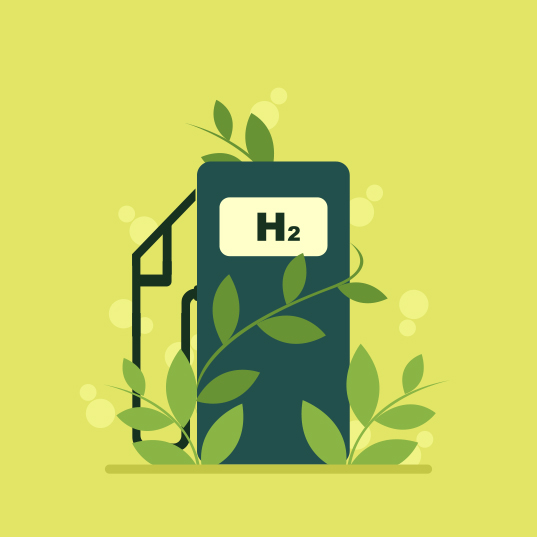Known as renewable hydrogen, green hydrogen production allows us to obtain a clean fuel from renewable energies. It is already seen as the great hope for substituting fossil fuels in sectors that are difficult to decarbonize. Both governments and the private sector recognize that hydrogen is an essential pillar of a fully sustainable energy transition.
What will I learn from this article?
How is green hydrogen produced
Global demand for hydrogen in 2020 was 90 million tonnes, according to the International Energy Agency (IEA), but most of it was produced from fossil fuels. Around 99% of hydrogen worldwide is produced from natural gas, coal or oil, the IEA estimates. These processes generate CO2 emissions, so the hydrogen generated in them is neither clean nor sustainable.
“Global demand for hydrogen in 2020 was 90 million tonnes”
If you prefer, you can also download this infographic
 These are processes such as molecular transformation, which consists of different techniques using chemical reactions to obtain hydrogen. Currently, the most-used method reforms natural gas from oil deposits, emitting carbon to the atmosphere.
These are processes such as molecular transformation, which consists of different techniques using chemical reactions to obtain hydrogen. Currently, the most-used method reforms natural gas from oil deposits, emitting carbon to the atmosphere.
Hydrogen can also be obtained by gasification from water vapor and pure oxygen, produced by burning coal or biomass. The coal or biomass is burned at high temperature in a reactor. During combustion, gases are freed that give rise on the one hand to hydrogen and on the other to carbon monoxide. Nor is this free of emissions.
The most sustainable and widespread method for producing green hydrogen is through electrolysis in water, using renewable electricity. This consists of breaking down water (H₂O) into oxygen (O2) and hydrogen (H2) gases using a continuous electric current passing between electrodes in water.
Countries leading the way in green hydrogen production
The race to lead green hydrogen production has begun and several world powers are competing to head the field. A report at the start of this year by the International Renewable Energy Agency (IRENA) analyzed political and economic changes occurring in the energy sector to focus on this new, clean fuel.
So who is leading the development of the political initiatives, technology and facilities to roll out green hydrogen?
China
China is the world’s biggest consumer and producer of hydrogen, but most production in the country is ‘grey’ hydrogen, i.e. generated using fossil fuels. Since 2019, however, China is changing tack. The Asian giant already has more than 30 green hydrogen projects underway, i.e. hydrogen produced from renewable energies.
China’s five-year plan recognizes hydrogen as one of the six industries of the future. Although it doesn’t have a national strategy as such, hydrogen figures in 16 provincial and municipal energy strategies.
European Union
The European Union (EU) has made it clear that hydrogen is one of its key technologies for achieving the objectives of the European Green Deal. EU plans include installing 40 Gigawatts (GW) of renewable hydrogen electrolyzers by 2030, a target which, if achieved, will make the EU an indisputable leader in green hydrogen production.
“EU plans include installing 40 Gigawatts (GW) of renewable hydrogen electrolyzers by 2030”
To achieve this, it has formed the European Clean Hydrogen Alliance, whose mission is to incentivize investment and roll-out green hydrogen projects on a large scale with the aim of decarbonizing the European economy.
Spain aspires to lead this race within Europe. It has the capacity to create a national project around renewable hydrogen, which will drive industry, technological expertise and job creation. The Spanish Government Road Map includes national objectives for the introduction of green hydrogen before 2030, including 4 GW of electrolyzers, and foresees a reduction in greenhouse gas emissions of the equivalent of 4.6 million tonnes of CO2.
India
Green hydrogen could help India achieve energy independence in 2047, said Prime Minister Narendra Modi during the presentation of the National Hydrogen Mission in 2021. The first stage of this plan focuses on incentivizing clean energy supply to meet the demand expected for this clean fuel.
Green hydrogen could be a great value-added opportunity for India, increasing its dependence on renewable energies to the detriment of imported fossil fuels, which currently cover most of the demand for oil and gas in the country.
Japan
Japan made history in 2017 by becoming the first country to formulate a national hydrogen strategy as part of its ambition to use this fuel in all sectors, according to the IRENA report. In 2020 alone, investment in technology related to hydrogen and fuel batteries was USD 670 million.
IRENA pointed out that, although Japan lacks the natural resources needed to achieve sufficient levels of wind or solar power to produce clean hydrogen itself, it is striking long-term supply agreements to import hydrogen.
South Korea
For South Korea, hydrogen is the motor of its economic development and job creation efforts, as stated in the country’s roadmap, which outlines the ambitious target of rolling out 200,000 fuel cell electric vehicles (FCEV) by 2025, a 20-fold increase on 2020.
South Korea also approved, in 2021, a Law for Hydrogen Economic Development and Safety Control, the first in the world aimed at promoting hydrogen vehicles, charging stations and fuel batteries.
Plans to develop and produce green hydrogen are proliferating worldwide. A reality that brings us closer to a future in which this fuel will finally be able to assume the role we need to decarbonize the planet.
Source:
- https://www.irena.org/publications/2022/Jan/Geopolitics-of-the-Energy-Transformation-Hydrogen